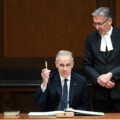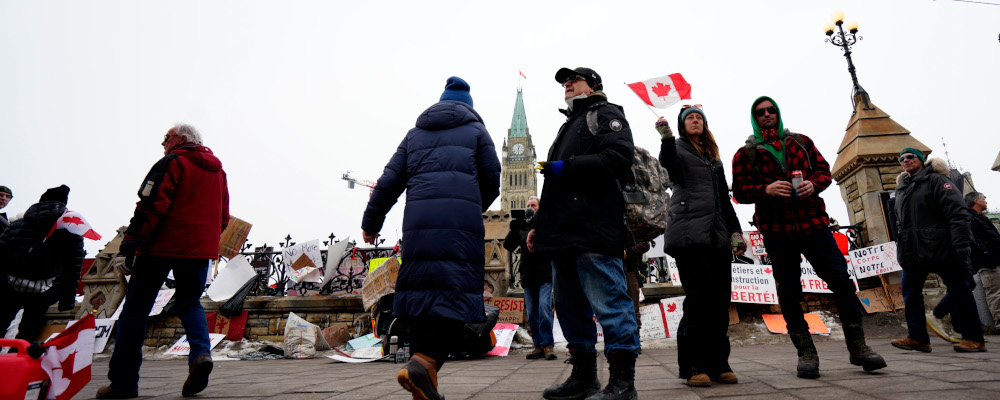2022 marks a major milestone for Canada: the 40th anniversary of the Constitution Act, 1982. This statute, which took effect on April 17, 1982, secured three major milestones for Canada.
First, it transferred full care and control over the Canadian Constitution from the United Kingdom to Canada. Second, it adopted a set of rules by which Canada could amend its Constitution. Third, it embedded a bill of rights, the Canadian Charter of Rights and Freedoms, into the Constitution. Barry Strayer, an esteemed Canadian jurist and one of the architects of the changes to our Constitution in 1982, aptly called this moment a constitutional revolution.
To mark this anniversary, I propose to make a whistle-stop journey through Canada’s constitutional history. This journey, which will finish in April to coincide with the anniversary of the Constitution Act, 1982, will have four stops: our constitutional landscape before 1982, how 1982 came about, the story after 1982, and the future of the Canadian Constitution.
The 40th anniversary of Canada’s constitutional revolution is an ideal moment to undertake what is a worthy endeavour at any time. In a society ruled by law, the portion of our law that governs all state action is of fundamental significance. The Constitution creates and sustains the basic features of Canadian society. It shapes our daily lives far more than we appreciate.
We only stand to benefit by deepening our knowledge of our Constitution. In doing so we will surely deepen our knowledge of Canada—a country that, though imperfect, merits affection and admiration. One might even say that, by learning about the law that constitutes Canada, we will grow in “true patriot love” for this remarkable country.
Part III: The Charter’s Imprint, Forty Years In
The Charter enshrines an array of rights and freedoms: fundamental freedoms, democratic rights, equality rights, and more.CONSTITUTION ACT, 1982 Canadians hold these rights and freedoms against the state. Where the state limits these rights and freedoms without sufficient justification, the state’s actions are legally void.
The Charter has reshaped Canadian society, primarily on account of how the Charter has been interpreted and applied by courts when state action is tested for compliance with the Charter. While it is impossible to fully cover this topic in this short essay, it is worth our while to obtain a sense of the imprint that the Charter has left since 1982.
The Charter has been, from early on, no stranger to controversial issues. In 1988, the Supreme Court struck down the crime of abortion as a breach of section 7 of the Charter. The Court concluded that the offence deprived women of liberty and security of the person in a manner that violated principles of fundamental justice. At the time, it was a criminal offence to perform or obtain an abortion unless it occurred at an accredited hospital with the approval of the hospital’s therapeutic abortion committee.
Section 7 has also played a role in the end-of-life context. In 2015, the Court decided that the crime of assisted suicide violates section 7. The Court declared that section 7 guarantees physician-assisted death for an adult who “clearly consents to the termination of life” and who has a “grievous and irremediable medical condition” that causes “enduring suffering that is intolerable to the individual”. Parliament has since expanded euthanasia beyond the end-of-life context, but the 2015 ruling opened the door.
The Charter also facilitated the delivery of same-sex marriage. In the early 2000s, several lower courts concluded that restricting marriage to one man and one woman offended the equality guarantee in section 15 of the Charter. In response, the federal government proposed a law to define marriage as the union of any two persons. Before Parliament voted on the law, however, the federal government asked the Supreme Court to weigh in. The Court concluded in 2004 that the proposed law not only complied with the Charter but respected it. In 2005, Parliament enacted the Civil Marriage Act.“In 2003, Ontario and British Columbia became the first two provinces to legalize same-sex marriage. The federal Civil Marriage Act came into force on 20 July 2005, making same-sex marriage legal across Canada. Canada became the fourth country to permit same-sex marriages, after the Netherlands (2000), Belgium (2003) and Spain (2005). Since then, all provinces in Canada have recognized same-sex marriages. Marriage itself falls under federal jurisdiction in Canada. But the provinces regulate the solemnization of marriage (the formal ceremony that is either civil or religious). They also grant marriage licenses. The Supreme Court has ruled that under the Charter of Rights and Freedoms, a religious official cannot be legally compelled to perform same-sex marriages if it is contrary to their religious beliefs.” https://www.thecanadianencyclopedia.ca/en/article/same-sex-marriage-in-canada
Section 15 of the Charter—the equality guarantee—has generated a significant number of Supreme Court rulings on topics ranging from spousal and parental benefits to pension schemes to meaningful access to medical services for persons with disabilities. In Andrews, the first ruling of the Supreme Court on section 15, the claimant met all the requirements to become a lawyer in British Columbia except one: he was not a Canadian citizen. Mr. Andrews challenged the law as an unjustifiable infringement of his right to equal treatment under the law. The Court agreed, endorsing a substantive conception of equality that “entails the promotion of a society in which all are secure in the knowledge that they are recognized at law as human beings equally deserving of concern, respect and consideration.”
Freedom of religion, found in section 2(a) of the Charter, has also been a major source of litigation. In Big M Drug Mart, the Court struck down the Lord’s Day Act as a violation of the state’s duty to be neutral in religious matters. The law forbade shopping on Sundays, effectively obliging all Canadians to observe the traditional Christian day of rest. In Hutterian Brethren, the Court ruled against members of an isolated religious community who, owing to their interpretation of the Bible, asked for an exemption from the requirement to take a photo for a driver’s license. In Multani, the Court ruled in favour of an orthodox Sikh student who wished to wear a ceremonial dagger at school in accordance with his faith.
The Charter has also had a lot to say about the criminal justice system. This is no surprise given that the Charter enshrines the rights to be free from unreasonable search and seizure, to not be arbitrarily arrested or detained, to be tried within a reasonable time, and to be presumed innocent until proven guilty. The “principles of fundamental justice” mentioned in section 7 have also shaped the contours of constitutional state action in the realm of criminal law. These principles oblige prosecutors to disclose to persons charged with crimes the evidence against them so that they can properly defend themselves. These principles also virtually bar the Canadian government from extraditing citizens for prosecution without assurances from the foreign government that the death penalty will not be pursued.
There are many other Charter rulings of the Supreme Court that could be mentioned here. There is the case that struck down the portions of the Criminal Code pertaining to prostitution. There is the case that upheld the hate speech provisions of the Criminal Code as a valid limit on freedom of expression. The Court also held that a law denying the vote to citizens who have resided outside of Canada for more than five years unjustifiably violated the right to vote. And then there is the case in which the Court came very close to ruling that a prohibition on private health care violates the Charter.
The Charter has left an indelible mark on Canadian society over the four decades of its existence. And that mark does not account for other constitutional milestones since 1982 that do not engage the Charter. Section 35 of the Constitution Act, 1982, for example, recognizes and affirms the “existing aboriginal and treaty rights of the aboriginal peoples of Canada.” This provision has generated several landmark rulings of the Supreme Court. In 2014, the Court issued its first declaration of aboriginal title in a case emanating from British Columbia concerning the Tsilhqot’in Nation.
We also should not overlook the continued relevance of the primary source of constitutional jurisprudence before 1982: the division of legislative powers between Parliament and the provinces. This arena of constitutional law has remained active since 1982. Last year, for example, the Supreme Court opined that the federal tax on greenhouse gas emissions respects the division of powers.
There have even been cases that have caused courts to consider constitutional provisions that were gathering dust. In Comeau, a case from 2018, the Supreme Court considered the extent to which provinces can limit interprovincial movement of goods. Section 121 of the Constitution Act, 1867 says that “All Articles of the Growth, Produce, or Manufacture of any one of the Provinces shall … be admitted free into each of the other Provinces.” When Mr. Comeau drove from New Brunswick to Quebec to buy cheaper beer, he was caught upon his return to New Brunswick and fined close to $300 pursuant to the Liquor Control Act of that province. Mr. Comeau argued that this scenario violated section 121, but the Supreme Court ruled against him.
Finally, there have been significant constitutional moments on the political stage. The Meech Lake“In 1987, Prime Minister Brian Mulroney attempted to win Quebec’s consent to the revised Canadian Constitution. The result was the Meech Lake Accord. It was an agreement between the federal and provincial governments to amend (change) the Constitution. The Accord proposed strengthening provincial powers and declaring Quebec a “distinct society.” The Accord was never put into effect. Political support for it unravelled in 1990. Many Québécois saw the Accord’s failure in English Canada as a rejection of Quebec. Support for separatism soared in Quebec and led to the 1995 Quebec Referendum.” https://www.thecanadianencyclopedia.ca/en/article/meech-lake-accord and Charlottetown Accords“The Charlottetown Accord of 1992 was a failed attempt by Prime Minister Brian Mulroney and all 10 provincial premiers to amend the Canadian Constitution. The goal was to obtain Quebec’s consent to the Constitution Act, 1982. The Accord would have recognized Quebec as a distinct society; decentralized many federal powers to the provinces; addressed the issue of Indigenous self-government; and reformed the Senate and the House of Commons. The Accord had the approval of the federal government and all 10 provincial governments. But it was rejected by Canadian voters in a referendum on 26 October 1992.” https://www.thecanadianencyclopedia.ca/en/article/the-charlottetown-accord of 1987 and 1992, spearheaded by Prime Minister Brian Mulroney, aimed to further amend the Constitution via the domestic amending formula adopted in 1982. The Accords, in broad terms, sought to bring Quebec fully into the constitutional fold after the province rejected the deal of 1982 as well as modify certain features of Canadian federalism.
The Meech Lake Accord failed to garner unanimous ratification by the provincial legislatures. The Charlottetown Accord evaporated after a national referendum failed to attract sufficient support for the Accord. The politics around the Accords would energize the sovereignty movement in Quebec and help pave the way to the referendum in 1995 that, by a razor-thin margin, yielded a vote against separation. This episode would set the stage for the Supreme Court, at the request of Parliament, to offer an opinion in 1998 on whether a province could unilaterally secede from Canada and what should occur if ever there were a referendum that yielded “a clear majority on a clear question in favour of secession”.
If the framers of 1982 thought that the constitutional changes of that year would bring about constitutional tranquility, they were sorely mistaken. The past forty years have featured intense activity on the constitutional front as governments have, mainly at the instruction of the courts, learned how to respect the Charter and the other components of the Canadian Constitution that arrived in 1982.
Today, in 2022, we would also be sorely mistaken to think that the learning of this sort is complete or nearing completion. Future constitutional milestones and landmark cases surely await us in the years to come. In the next and final part of this series, we will consider what they might be.
Recommended for You

The Notebook by Theo Argitis: Carney’s One Big Beautiful Tax Cut, and fresh budget lessons from the U.K.

Christopher Snook: Is Canada sleepwalking into dystopia?

Rudyard Griffiths and Sean Speer: The fiscal hangover from the One Big Beautiful Bill hits Canada

‘A fiscal headache for Mark Carney’: The Roundtable on how Trump’s One Big Beautiful Bill could affect Canada




